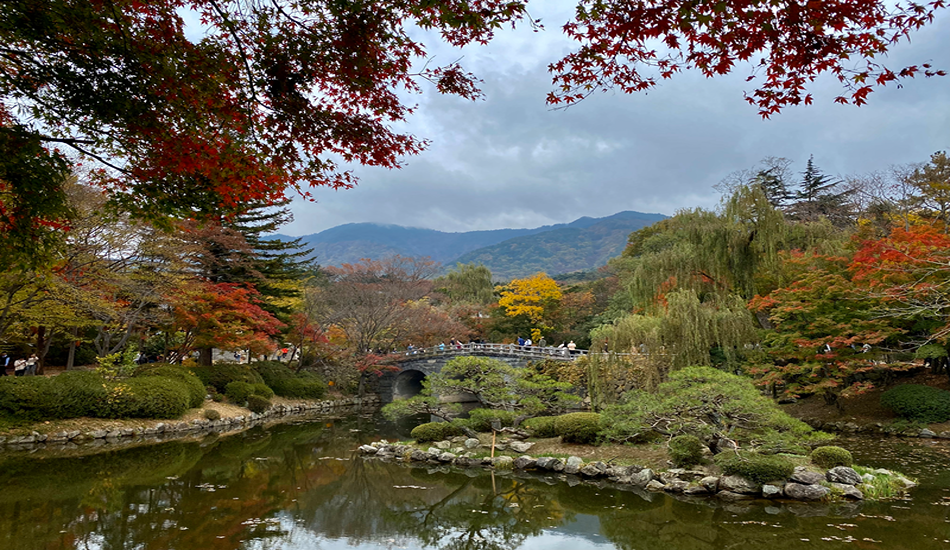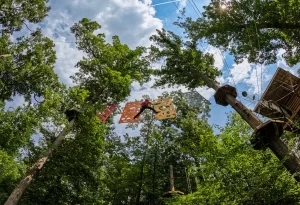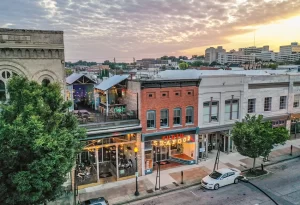October and November are great times to visit South Korea and Japan. Inside Travel Group’s senior consultant lists some advantages of going in the fall.
While cherry blossom season in spring is certainly the most popular seasonal phenomenon that attracts travelers to Asia, the other shoulder season—fall—offers a visual feast of colors as well. In Japan and South Korea, leaves of the maple and gingko trees that dot the mountainous countries reveal rich, bronze, red, orange and golden hues, painting the landscapes of ancient villages, bustling cities and wilderness regions with their tantalizing autumn brilliance.
For travelers looking to experience fall foliage on the other side of the Pacific, Inside Travel Group, parent brand to InsideJapan Tours and InsideAsiaTours, has outlined some insightful tips for a fall foliage getaway in Japan or South Korea. Customizable, small-group itineraries showcase the top sites for experiencing the best that fall has to offer.
For more travel ideas and information, be sure to Subscribe to Leisure Group Travel for FREE
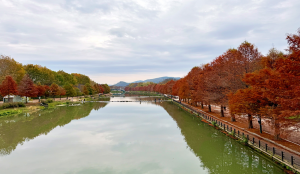
Fall colors in Gwangju, South Korea. (Photo credit: InsideAsia Tours)
4 Fall Foliage Travel Tips for Japan and South Korea
Karin Tompkins Takahashi, Inside Travel Group’s senior travel consultant and Japan and South Korea specialist, offers these observations for fall foliage travel:
- Peak season timing: While October is the peak time for leaf-peeping in the Northeast United States, foliage in Japan and South Korea reaches its apex in mid-November. The cooler temperatures in both countries make exploring the ancient temples, maze-like food markets and natural wonders of Japan and South Korea far more comfortable than the sweltering humidity of summer and bitter cold of winter.
- Find foliage in the city: Asia’s cities are completely different than Western cities, with natural areas integrated into the urban layout seamlessly preserving the natural feel despite modern development. This means that fall foliage can be experienced within Japan and Korea’s mega-cities of Seoul and Tokyo without having to retreat to the rural mountains, thanks to both cities featuring several world-class parks and mountains right outside the city limits easily reachable via public transport. This convenience allows travelers to have more complete, full days of activities and cultural immersion under the dazzling shades of November’s fall foliage hues.
- Sample the fall harvest: Both Japan and South Korea are known for their world-class food scenes, and autumn features several delicacies that are best enjoyed when the harvest is fresh. In Japan, the sanma fish (translates to autumn knife fish) is caught primarily in fall and is used in several dishes, ranging from grilled filets to sushi. Japanese sweet potatoes, or yakiimo, are also harvested in the fall, with their earthy, robust flavors perfect for the brisk air and laid-back atmosphere of the season. The famous Matsutake mushrooms, also harvested in the fall, are used as accents in several fall dishes that utilize seasonal gourds and fruits.
Japan and South Korea enjoy persimmons (kaki in Japan, gam in Korea), both on their own and in dishes that are special to the season. Their bright orange hue just says autumn. Also popular in fall are chestnuts (kuri in Japan), served hot as a comforting snack in Japan and Korea as early as October when the harvest starts.
- Fall festivals: The spirit of transformation brought about by the changing colors of leaves is felt in many fall festivals. In South Korea, the Jinju Namgang Yudeung Lantern Festival and Andong Mask Dance Festival take place around October and November each year. The former is held within an ancient fortress and showcases the beautiful floating lanterns that are pivotal to South Korea’s military history, while the latter celebrates the beautiful masks from around the world within the UNESCO site of Andong Hahoe Village.
Across the Sea of Japan, the Karatsu Kunchi festival in Kyushu features bombastic parades of massive kikiyama samurai floats, along with dragons, sea bream and other mythic creatures from the region’s history. Complete with taiko drummers, the three-day celebration is coordinated by the local Shinto shrine.
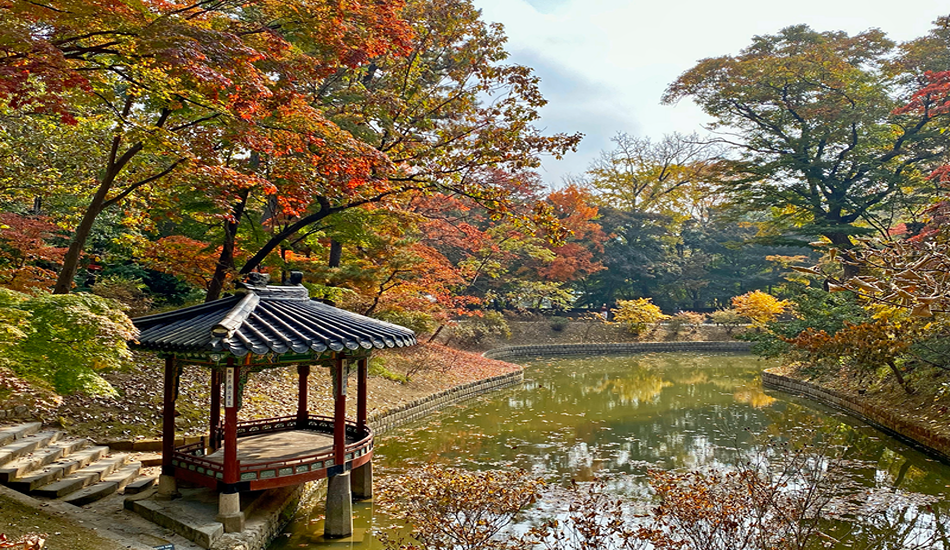
Changdeokgung Palace in Seoul, South Korea. (Photo credit: InsideAsia Tours)
Autumn Leaves in Seoul, South Korea
No trip to Seoul would be complete with a stop at Gyeongbokgung Palace, the largest of Seoul’s five grand palaces with expansive grounds framed by ancient gingko and maple trees adorning the palace buildings in vibrant shades in autumn. Namsan Park in central Seoul treats travelers to panoramic views of the city, with winding trails and forested slopes dotted with maple and cherry trees, creating a mesmerizing tapestry of colors. To take in Seoul views from as high as possible, the top of Namsan Mountain is home to the iconic N Seoul Tower, which showcases the city’s impressive skyline against the backdrop of the fiery foliage of Namsan Park from the tower’s many observation decks.
To change it up and rest the feet a bit, a relaxing cruise along the tranquil waters of the Hangang River, which winds its way through the heart of Seoul, will treat travelers to breathtaking views of riverside parks ablaze with fall colors. With an oxymoronic name, Seoul Forest is a sprawling urban oasis of trees and streams that bursts into a riot of colors during the fall season, further enhancing the serene retreat from the bustling city found in its vast woodlands, wetlands and gardens. If travelers want to take in more recent history, Olympic Park, site of the 1988 Seoul Summer Olympics, boasts expansive green spaces and wooded trails that offer plenty of opportunities to admire the changing leaves against the backdrop of iconic Olympic landmarks.
Autumn Leaves in Kyoto, Japan
Kyoto boasts an exquisite array of traditional gardens, temples and shrines, all aglow with the resplendent hues of autumn. Among the most renowned sites are Tofukuji Temple, Kiyomizudera and the adjacent Kodaiji, where evening illuminations enhance the seasonal spectacle. Other enchanting options for leaf peeping include Shinyodo, nestled closer to the Philosopher’s Walk, and Ginkakuji Temple, renowned for its profusion of maple trees. Daigoji offers another captivating choice, with its maple trees encircling a tranquil pond and a picturesque red bridge.
For those seeking a more remote leaf-viewing experience, the Nazenin and Tenjuan sub-temples near Nanzenji Temple offer a less visited but just as history-rich and naturally beautiful experience. Beyond the bustling heart of Kyoto lies the breathtaking Arashiyama district, where mountains clothed in forests dazzle visitors with their autumnal splendor. Be prepared, however, as Arashiyama tends to draw considerable crowds during this season.
Autumn Leaves in Tokyo, Japan
Indulge in a day of exploration amidst Tokyo’s most cherished locales, where the mesmerizing transformation of fall foliage awaits. Iconic landscape gardens, Rikugien and Koishikawa Korakuen, are built with meandering pathways offering enchanting vistas of maple leaves ablaze with color. For a tranquil respite amidst the urban sprawl of Tokyo, the expansive greenery of Shinjuku Gyoen and Yoyogi Gyoen unveil tapestries of natural beauty in pockets of nature tucked into the tight corners of Tokyo.
Nearby, Meiji Jingu Gaien Park beckons with its famed Icho Namiki, an avenue flanked by gingko trees aglow in radiant gold during late November. And for a rejuvenating escape from the city, a day trip to the outskirts of Tokyo can feature a climb up Mt. Takao, where nature’s splendor unfolds in a pristine, untouched setting.
For more travel ideas and information, be sure to Subscribe to Leisure Group Travel for FREE
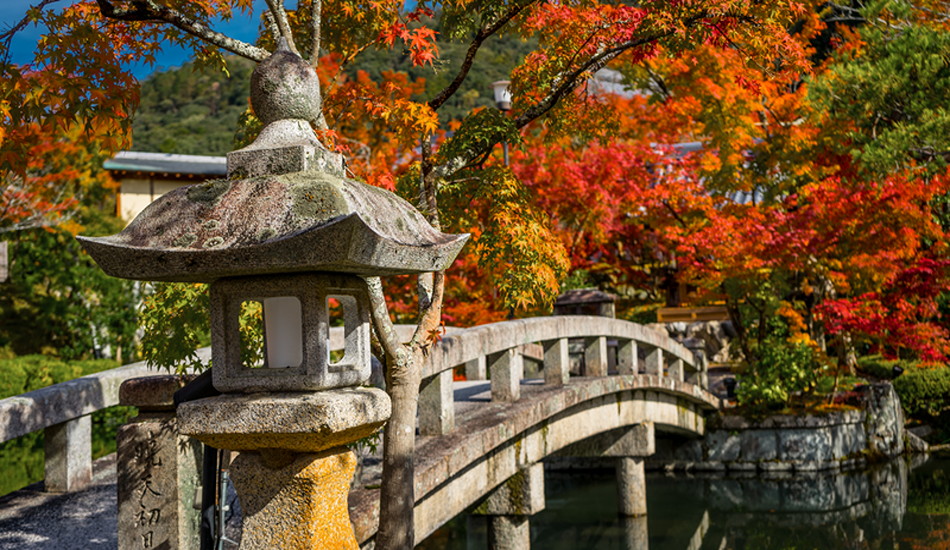
Brilliant fall colors frame a bridge in Kyoto, Japan. (Photo credit: InsideJapan Tours)
Sample Fall Itinerary from Inside Travel Group
Here is one of InsideJapan Tours’ popular fall itineraries:
Autumn Splendor, 14 nights, from $3,737 (twin share). This special seasonal itinerary from InsideJapan Tours is designed to showcase the best of Japan’s main island, Honshu, during October and November. Just as in spring, the parks and countryside are packed with revelers gathering for hanami (blossom-viewing) parties; during these months the Japanese flock to their favorite spots to appreciate the autumn leaves, known as koyo or momiji.
Whether you depart earlier or later in the fall, you are bound to see stunning colors. October brings gorgeous autumn foliage to Kamikochi National Parks, while colors are at their best in Tokyo and Kyoto’s temples around mid-November.
In Tokyo’s city center, Gingko Avenue turns bright yellow in autumn, while the city’s parks and gardens—particularly Rikugien Park and Koishikawa Korakuen—are also excellent places to admire a variety of fall colors.
No trip to Honshu at this time of year would be complete without venturing into the Japanese Alps. The samurai castle town of Matsumoto provides a handy stepping stone on your autumn adventure. Then it’s on to Kamikochi National Park. In October this area of protected natural beauty is ablaze with color, providing a gorgeous backdrop to a couple of days hiking.
Next up is Takayama, where you’ll stay at an authentic inn, sleeping on thick futon mattresses rolled out on the tatami mat floor. Kanazawa makes a great next stop, where Kenrokuen Gardens becomes a riot of color in October and November.
Then on to Kyoto, the “City of Ten Thousand Temples,” where temples are lit up at night to show off the seasonal colors.
For more ideas on Asia travel, you can subscribe to Leisure Group Travel for FREE
Lead photo – Bulguksa Temple in Gyeongju, South Korea. (Photo credit: InsideAsia Tours)


